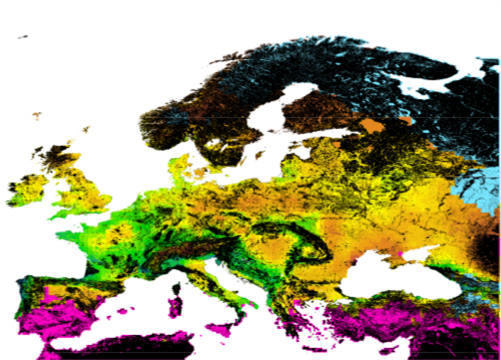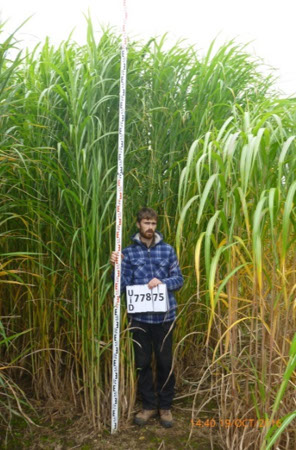

M i s c a n t h u s B r e e d i n g


GIANT LINK - Genetic improvement of Miscanthus to be a sustainable feedstock for bioenergy in the UK (LK0863)
Renewable Materials
LINK Programme
Project factsheet
Background
Biomass-derived energy is renewable and low carbon. Low input perennial biomass crops such as the giant grass Miscanthus are a useful source of raw material needed for producing bioenergy in the UK and elsewhere. Energy crops also provide an important option for farmers, providing environmental benefits, such as GHG mitigation and soil carbon sequestration (depending on previous land use). Miscanthus requires low inputs owing to the efficient recycling of nutrients from above ground biomass to below ground rhizomes in the autumn and winter, with harvest of above ground biomass in late winter or early spring. Commercial uptake has suffered from lack of diverse varieties and poor farmer economics.
Methods
- GIANT helped create and curate the largest ex-situ Miscanthus collection outside Asia for breeding whilst respecting the Convention on Biology Diversity and Nagoya Protocols on genetic resources
- >3500 breeding crosses were made to identify key parental combinations producing seed-based hybrids which compare or exceed the performance of the current, clonal hybrid
- The database MSCAN and mathematical modelling was used at all stages to retain and analyse impacts of key traits on feedstock potential
- Commercial style seed production experiments in US and Europe with >10 candidate hybrids which were planted in plot trials at ~15 sites in EU (6 in the UK) using plug plant agronomy developed in GIANT
Results
- Major advances in yield due to genetic improvement in breeding
- Conversion of the crop to a seed-based hybrid for improved economics and scale-ability
- Comprehensive field to furnace environmental assessment showing net environmental benefits
- Land use, market potential and business economics analysis
- Development of efficient field scale planting and management techniques
- Commercialisation and market development
Further work
Analysis of G X E effects in terms of yield and composition on novel seed hybrids is underway and being taken forward in succession projects with UK and EU funding


Above: MiscanFor model v2016 (Hastings et al.) annual harvestable yields for Mxg. As new GIANT (“GNT”) hybrids mature, this map will be revised.
Selected publications
Clifton-Brown, J.,et al.. 2013. Breeding Miscanthus for bioenergy. In: Saha M, Bhandhari S, eds. Bioenergy Feedstocks: Breeding and Genetics: Wiley-Blackwell, 67-79.
Clifton-Brown, J., Schwarz, K.U., Hastings, A. 2015. History of the Development of Miscanthus as a Bioenergy Crop: From Small Beginnings to Potential Realisation. Biology and Environment-Proceedings of the Royal Irish Academy 115B, 45-57.
Clifton-Brown, J.C., Hastings, A., Mos, M.M., et al.. 2016a. Progress in upscaling Miscanthus biomass production for the European bioeconomy with seed based hybrids. Global Change Biology - Bioenergy DOI: 10.1111/gcbb.12357, 12.
Davey, C.J., Laurence; Squance, Michael; Purdy, Sarah; Maddison, Anne; Cunniff, Jennifer; Donnison, Iain; Clifton-Brown, John. 2016. Radiation capture and conversion efficiencies of Miscanthus sacchariflorus, M. sinensis and their naturally occurring hybrid M. x giganteus. Global Change Biology - Bioenergy DOI: 10.1111/gcbb.12331.
Jensen, E.R., Paul; Farrar, Kerrie; Thomas-Jones, Sian; Clifton-Brown, John; Donnison, Iain; Payne, Roger. 2016. Early flowering and senescence improve Miscanthus biomass combustion quality. Global Change Biology - Bioenergy Accepted 20 June 2016.
McCalmont, J., Hastings, A., McNamara, N.P., Richter, G.M., Robson, P., Clifton-Brown, J.C. 2015. Environmental Costs and Benefits of Growing Miscanthus for Bioenergy in the UK. Global Change Biology - Bioenergy DOI: 10.1111/gcbb.12294.
McCalmont, J., McNamara, N.P., Donnison, I., Farrar, K., Clifton-Brown, J. 2016. Partitioning of ecosystem respiration of CO2 released during land-use transition from temperate agricultural grassland to Miscanthus x giganteus. Global Change Biology - Bioenergy Accepted 13 June 2016.
Slavov, G. 2013. Contrasting geographic patterns of genetic variation for molecular markers vs. phenotypic traits in the energy grass Miscanthus sinensis. Global Change Biology Bioenergy 5, 562-571.
Slavov, G.T. 2014. Genome-wide association studies and prediction of 17 traits related to phenology, biomass and cell wall composition in the energy grass Miscanthus sinensis. New Phytologist 201, 1227-1239.
Project Manager:
- Professor John Clifton-Brown, Aberystwyth University
Project Duration:
- 1 April 2011 to 31 July 2106
Project consortium:
- Aberystwyth University
- University of Aberdeen
- CERES Inc.
- Terravesta Ltd.
- E.ON (now Uniper)
- Biocatalysts Ltd.
- Blankney Estates
- National Farmers Union (NFU)









Above: A new seed-based hybrid produced within GIANT LINK with Mxg, the standard, in the foreground. Photo: Hackthorn, Lincoln




M i s c a n t h u s B r e e d i n g t o p r o v i d e s u s t a i n a b l e g l o b a l b i o e n e r g y f o r t h e f u t u r e